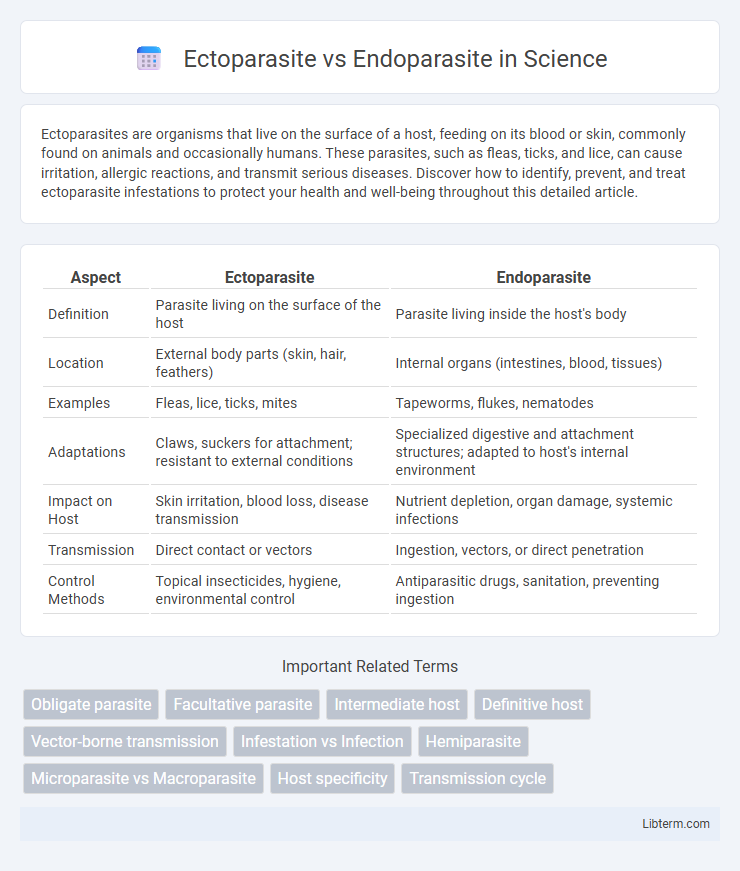Ectoparasites are organisms that live on the surface of a host, feeding on its blood or skin, commonly found on animals and occasionally humans. These parasites, such as fleas, ticks, and lice, can cause irritation, allergic reactions, and transmit serious diseases. Discover how to identify, prevent, and treat ectoparasite infestations to protect your health and well-being throughout this detailed article.
Table of Comparison
| Aspect | Ectoparasite | Endoparasite |
|---|---|---|
| Definition | Parasite living on the surface of the host | Parasite living inside the host's body |
| Location | External body parts (skin, hair, feathers) | Internal organs (intestines, blood, tissues) |
| Examples | Fleas, lice, ticks, mites | Tapeworms, flukes, nematodes |
| Adaptations | Claws, suckers for attachment; resistant to external conditions | Specialized digestive and attachment structures; adapted to host's internal environment |
| Impact on Host | Skin irritation, blood loss, disease transmission | Nutrient depletion, organ damage, systemic infections |
| Transmission | Direct contact or vectors | Ingestion, vectors, or direct penetration |
| Control Methods | Topical insecticides, hygiene, environmental control | Antiparasitic drugs, sanitation, preventing ingestion |
Introduction to Parasites
Ectoparasites live on the external surface of their hosts, feeding on blood or skin, and include organisms like fleas, ticks, and lice. Endoparasites reside inside the host's body, inhabiting organs or tissues, examples being tapeworms, roundworms, and protozoa such as Plasmodium. Both types of parasites impact host health through nutrient depletion and disease transmission, playing crucial roles in ecological and medical parasitology.
Defining Ectoparasites
Ectoparasites are organisms that live on the external surface of a host, obtaining nutrients directly from the host's skin or blood. Common examples include ticks, fleas, and lice, which attach to mammals, birds, and reptiles, causing irritation and potential disease transmission. Their ability to exploit the host's exterior environment differentiates them fundamentally from endoparasites, which reside inside the host's body.
Common Types of Ectoparasites
Common types of ectoparasites include lice, fleas, mites, and ticks, which live on the surface of the host's skin, feeding on blood or skin debris. These parasites are responsible for transmitting various diseases such as Lyme disease and typhus, making them significant vectors in human and animal health. Unlike endoparasites that reside inside the host's body, ectoparasites are external and often cause irritation, allergic reactions, or secondary infections.
Defining Endoparasites
Endoparasites are organisms that live inside the host's body, often within organs or tissues, causing chronic infections or diseases by extracting nutrients directly from host cells or bodily fluids. Unlike ectoparasites that inhabit the host's surface, endoparasites include protozoa, helminths, and certain bacteria, which evade immune responses through complex life cycles and tissue localization. Understanding endoparasites is crucial for controlling diseases such as malaria, schistosomiasis, and toxoplasmosis, which impact human and animal health worldwide.
Common Types of Endoparasites
Common types of endoparasites include protozoa such as Plasmodium, which causes malaria, and helminths like roundworms (Ascaris), tapeworms (Taenia), and flukes (Schistosoma). These parasites live inside the host's body, often inhabiting organs such as the intestines, liver, or blood, causing diseases that can affect nutrient absorption and organ function. Endoparasitic infections require targeted treatments, often involving antiparasitic medications specific to the parasite type and lifecycle.
Key Differences Between Ectoparasites and Endoparasites
Ectoparasites live on the external surface of their host, feeding on skin, blood, or other bodily fluids, while endoparasites inhabit the internal organs or tissues, deriving nutrients directly from inside the host. Ectoparasites include organisms like lice, ticks, and fleas, causing irritation and potential transmission of diseases externally, whereas endoparasites such as tapeworms, roundworms, and protozoans often cause systemic infections and nutritional deficiencies. The main differences lie in their habitat, mode of interaction with the host, and the resulting pathological effects on the host organism.
Life Cycles of Ectoparasites vs Endoparasites
Ectoparasites, such as ticks and lice, have life cycles that involve multiple developmental stages (egg, larva, nymph, and adult) primarily occurring on the host's external surface, often requiring environmental conditions for off-host maturation. Endoparasites, including tapeworms and flukes, complete complex life cycles within one or more hosts, frequently involving multiple larval stages inside intermediate hosts before reaching maturity in the definitive host. The distinct life cycles reflect adaptations to their respective ecological niches, with ectoparasites relying on external attachment and feeding, while endoparasites undergo internal development and nutrient absorption within host tissues.
Health Impacts on Hosts
Ectoparasites such as ticks and lice cause external irritation, leading to skin infections, anemia, and allergic reactions in hosts. Endoparasites, including tapeworms and roundworms, disrupt nutrient absorption and damage internal organs, resulting in malnutrition, weakened immunity, and chronic disease. Both parasite types significantly impair host health by promoting disease transmission and physiological stress.
Diagnosis and Treatment Methods
Diagnosis of ectoparasites typically involves visual inspection and skin scrapings to identify parasites such as lice, ticks, or mites, while endoparasite diagnosis relies on stool analysis, blood tests, or imaging techniques to detect internal parasites like helminths or protozoa. Treatment of ectoparasites often includes topical insecticides, anti-parasitic shampoos, and environmental decontamination, whereas endoparasite treatment commonly uses oral anthelmintics or antiprotozoal medications tailored to the specific parasite species. Accurate diagnosis ensures targeted therapy, reducing the risk of resistance and promoting effective parasite eradication.
Prevention and Control Strategies
Effective prevention and control strategies for ectoparasites such as ticks and fleas involve regular use of insecticides, maintaining proper hygiene, and environmental management to eliminate breeding sites. Endoparasite control, including for worms and protozoa, requires routine anthelmintic treatments, safe food and water practices, and improved sanitation to interrupt transmission cycles. Integrated pest management combining chemical, biological, and environmental measures enhances the effectiveness of controlling both ectoparasite and endoparasite infestations.
Ectoparasite Infographic

 libterm.com
libterm.com